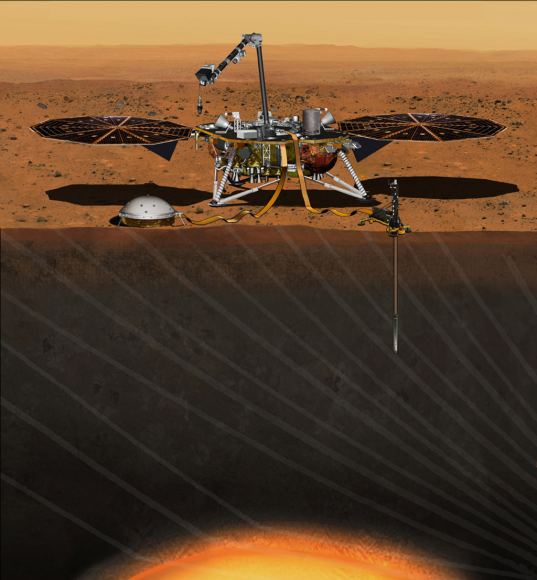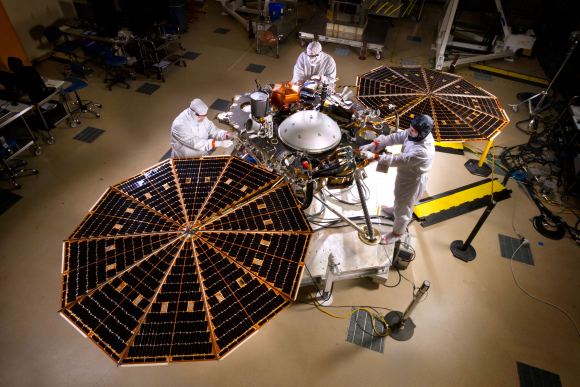This summer has been a busy time for NASA. At present, the agency is making the final preparations for the Cassini mission‘s plunge into Saturn’s atmosphere, monitoring the large Near-Earth Asteroid that recently made a flyby of Earth, marking the 40th anniversary of the historic Voyager missions, and hosting the Summer of Mars at the Kennedy Space Center.
In addition to all that, engineers at the Jet Propulsion Laboratory in Pasadena, California, are busy preparing the Interior Exploration using Seismic Investigations, Geodesy and Heat Transport (InSight) Lander for its scheduled launch in 2018. Once deployed to Mars, the lander will reveal things about Mars’ interior geology and composition, shedding new light on the history of the Red Planet’s formation and evolution.
Originally scheduled for launch in 2016, the lander’s deployment was delayed due to the failure of a key component – a chamber that housed the Seismic Experiment for Interior Structure (SEIS). Having finished work on a new vacuum enclosure for this instrument, the technicians at Lockheed Martin Space Systems are back at work, assembling and testing the spacecraft in a clean room facility outside of Denver, Colorado.

As Stu Spath, the spacecraft program manager at Lockheed Martin, said in a NASA press statement:
“Our team resumed system-level integration and test activities last month. The lander is completed and instruments have been integrated onto it so that we can complete the final spacecraft testing including acoustics, instrument deployments and thermal balance tests.”
Beyond the exploration of Mars, the InSight mission is also expected to reveal information about how all terrestrial (i.e. rocky) planets in the Solar System formed over four billion years ago. Mars is an especially opportune target for this type of research since it has been relatively inactive for the past three billion years. However, when the planet was still young, it underwent geological processes that were analogous to Earth’s.
In other words, because the interior of Mars has been subject to less convection over the past three billion years, it has likely preserved evidence about its early geological history better than Earth has. InSight will study this preserved history through a series of instruments that will measure the planet’s seismology, heat loss, and the state and nature of its core.
Once it reaches Mars, the stationary lander will set down near Mars’ equator and deploy its two fold-out solar cells, which kind of resemble large fans. Within a few weeks of making its landing, it will use a robotic arm to place its two main instruments onto the Martian surface – the aforementioned Seismic Experiment for Interior Structure (SEIS) and the Heat Flow and Physical Properties Probe (HP³).

The SEIS instrument – which was developed by France’s National Center for Space Studies (CNES) in collaboration with NASA and several European scientific institutions – has a sensitivity comparable to the best research seismometers here on Earth. This instrument will record seismic waves from “marsquakes” and meteor impacts, which will reveal things about the planet’s interior layers.
The HP³ probe, supplied by the German Aerospace Center (DLR), will use a Polish-made self-hammering mechanism to bury itself to a depth of 3 meters (10 feet) or more. As it descends, the probe will extend a tether that contains temperature sensors every ~10 cm, which measure the temperature profile of the subsurface. Combined with surface measurements, the instrument will determine the amount of heat escaping from the planet’s interior.
A third experiment, known as Rotation and Interior Structure Experiment (RISE), will also come into play. This instrument will use the lander’s X-band radio link to conduct Doppler tracking of the lander’s location, which will also allow it to measure variations in Mars’ rotation axis. Since these variations are primarily related to the size and state of Mars’ core, this experiment will shed light on one of Mars’ greatest mysteries.
Thanks to multiple missions that have studies Mars’ surface and atmosphere, scientists now know that roughly 4.2 billions of years ago, Mars lost its magnetic field. Because of this, Mars’ atmosphere was stripped away by solar wind during the next 500 million years. It is believed that it was this process that allowed the planet to go from being a warmer, wetter environment in the past to the cold, desiccated and irradiated place it is today.

As such, determining the state of Mars’ core – i.e. whether it is solid or liquid, or differentiated between a solid outer core and liquid inner core – will allow scientists to gain a more comprehensive understanding of the planet’s geological history. It will also allow them to answer with a fair degree of certainty how and when Mars lost its magnetic field (and hence, its denser, warmer atmosphere).
The spacecraft’s science payload is also on track for next year’s launch. At present, the mission is scheduled to launch on May 5th, 2018, though this window could be moved to anytime within a five-week period. Regardless of what day it launches, mission planners indicate that the flight will reach Mars on November 26th, 2018 (the Monday after Thanksgiving).
As noted, the mission was originally planned to launch in March of 2016, but was canceled due to the presence of a leak in the special metal container designed to maintain near-vacuum conditions around the SEIS’s main sensors. Now that a redesigned vacuum vessel has been built and tested (and integrated with the SEIS) the spacecraft is ready for its new launch date.
Back in 2010, the InSight mission was selected from a total of 28 proposals, which were made as part of the twelfth round of selections for NASA’s Discovery Program. In contrast to New Frontiers or Flagship programs, Discovery missions are small-budget enterprises that aid in larger scientific pursuits. Along with two other finalists – the Titan Mare Explorer (TiME) and the Comet Hopper (CHopper) – InSight was awarded funding for further development.
Bruce Banerdt of NASA’s Jet Propulsion Laboratory is the Principle Investigator (PI) for the InSight mission.
Be sure to check out this video of the InSight mission (courtesy of NASA JPL) as well:
Further Reading: NASA JPL

